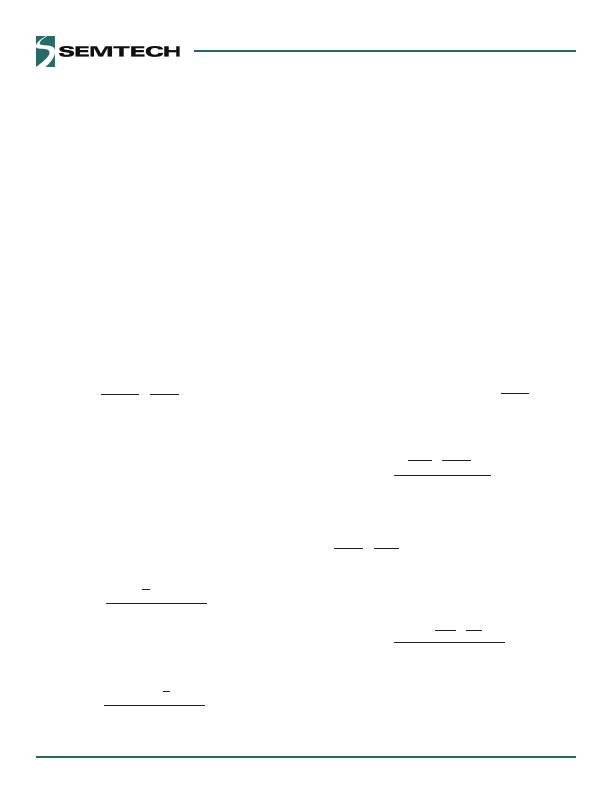
SC418
23
Applications Information (continued)
Capacitor Selection
The output capacitors are chosen based on required ESR
and capacitance. The maximum ESR requirement is con-
trolled by the output ripple requirement and the DC toler-
ance. The output voltage has a DC value that is equal to
the valley of the output ripple plus /2 of the peak-to-peak
ripple. Change in the output ripple voltage will lead to a
change in DC voltage at the output.
The design goal is for the output voltage regulation to be
?% under static conditions. The internal 500mV refer-
ence tolerance is %. Allowing % tolerance from the FB
resistor divider, this allows 2% tolerance due to V
OUT
ripple.
Since this 2% error comes from /2 of the ripple voltage,
the allowable ripple is 4%, or 42mV for a .05V output.
The maximum ripple current of 4.4A creates a ripple
voltage across the ESR. The maximum ESR value allowed
is shown by the following equations.
A
4
.
4
mV
42
I
V
ESR
RIPPLEMAX
RIPPLE
MAX
ESR
MAX
= 9.5 m&
The output capacitance is chosen to meet transient
requirements. A worst-case load release, from maximum
load to no load at the exact moment when inductor
current is at the peak, determines the required capaci-
tance. If the load release is instantaneous (load changes
from maximum to zero in < 祍), the output capacitor
must absorb all the inductors stored energy. This will
cause a peak voltage on the capacitor according to the
following equation.
2
OUT
2
PEAK
2
RIPPLEMAX
OUT
MIN
V
V
I
2
1
I
L
COUT
Assuming a peak voltage V
PEAK
of .50 (00mV rise upon
load release), and a 0A load release, the required capaci-
tance is shown by the next equation.
2
2
2
MIN
05
.
1
15
.
1
4
.
4
2
1
10
H
88
.
0
COUT
COUT
MIN
= 595礔
If the load release is relatively slow, the output capacitance
can be reduced. At heavy loads during normal switching,
when the FB pin is above the 500mV reference, the DL
output is high and the low-side MOSFET is on. During this
time, the voltage across the inductor is approximately
-V
OUT
. This causes a down-slope or falling di/dt in the
inductor. If the load di/dt is not faster than the -di/dt in
the inductor, then the inductor current will tend to track
the falling load current. This will reduce the excess induc-
tive energy that must be absorbed by the output capaci-
tor, therefore a smaller capacitance can be used.
The following can be used to calculate the needed capaci-
tance for a given dI
LOAD
/dt. Peak inductor current is shown
by the next equation.
I
LPK
= I
MAX
+ 1/2 x I
RIPPLEMAX
I
LPK
= 10 + 1/2 x 4.4 = 12.2A
dt
dl
Current
Load
of
change
of
Rate
LOAD
I
MAX
= maximum load release = 10A
OUT
PK
LOAD
MAX
OUT
LPK
LPK
OUT
V
V
2
dt
dl
I
V
I
L
I
C
Example
s
A
5
.
2
dt
dl
LOAD
This would cause the output current to move from 0A to
zero in 4祍 as shown by the following equation.
05
.
1
15
.
1
2
s
1
5
.
2
10
05
.
1
2
.
12
H
88
.
0
2
.
12
C
OUT
C
OUT
= 379礔
Note that C
OUT
is much smaller in this example, 379礔
compared to 595礔 based on a worst-case load release. To
发布紧急采购,3分钟左右您将得到回复。
相关PDF资料
SC424MLTRT
IC REG DL BUCK/LINEAR 28MLPQ
SC4250LISTRT
IC HOT SWAP CTRLR 8-SOIC
SC427MLTRT
IC REG DL BUCK/LINEAR 32MLPQ
SE95D,112
IC SENSOR TEMP 2.8-5.5V SOT96-1
SE97BTP,547
IC TEMP SENSOR DIMM 8HWSON
SE98ATP,547
IC TEMP SENSOR DDR 8-HWSON
SG6901ASZ
IC PFC CTLR AVERAGE CURR 20SOIC
SG6932SZ
IC PFC CONTROLLER CCM 16SOP
相关代理商/技术参数
SC419
制造商:SEMTECH 制造商全称:Semtech Corporation 功能描述:EcoSpeedTM DC-DC Converter with Integrated Boost Diode
SC419970CGCR2
制造商:Motorola Inc 功能描述:
SC419EVB
制造商:SEMTECH 制造商全称:Semtech Corporation 功能描述:EcoSpeedTM DC-DC Converter with Integrated Boost Diode
SC419ULTRT
功能描述:IC REG CTRLR BUCK PWM 20-MLPQ RoHS:是 类别:集成电路 (IC) >> PMIC - 稳压器 - DC DC 切换控制器 系列:EcoSpeed®, SmartDrive™ 特色产品:LM3753/54 Scalable 2-Phase Synchronous Buck Controllers 标准包装:1 系列:PowerWise® PWM 型:电压模式 输出数:1 频率 - 最大:1MHz 占空比:81% 电源电压:4.5 V ~ 18 V 降压:是 升压:无 回扫:无 反相:无 倍增器:无 除法器:无 Cuk:无 隔离:无 工作温度:-5°C ~ 125°C 封装/外壳:32-WFQFN 裸露焊盘 包装:Digi-Reel® 产品目录页面:1303 (CN2011-ZH PDF) 其它名称:LM3754SQDKR
SC41E6
制造商:INFINEON 制造商全称:Infineon Technologies AG 功能描述:SIEMENS ANNOUNCES A SUB-MICTON GENERATION OF CHANNELLESS GATE-ARRAYS BASED ON THE PROVEN MEGALOGIC PROCESS
SC4-2 24VDC
制造商:PEPPERL+FUCHS 功能描述:Sensor, Machine Safety, Control Unit, 24VDC, 2 Channel, LED Display, 117230
SC420
功能描述:UPS - 不间断电源 420VA/260W 4 Outlet
RoHS:否 制造商:Phoenix Contact 功率额定值: 输出电压额定值:24 V 出口数量:2 运行时间(满载): 运行时间(半载):
SC4201
制造商:SEMTECH 制造商全称:Semtech Corporation 功能描述:Multi-Phase Link Controller
